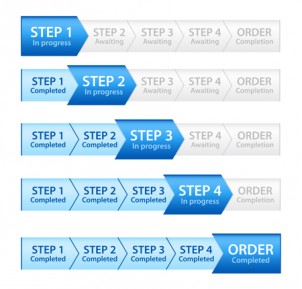1 min read
Uncovering the Real Benefits of MES and Paperless Manufacturing
Curious to know the real benefits of MES, we asked a shop floor production team what the top benefits of the system were one month after their...

There are times when a potential solution may cause more trouble than the problem itself. A good example… the day I decided to use a hammer to open a jar of peanut butter. It was a disaster we still call the “great peanut butter explosion.” Another example – my neighbor tried to use a chainsaw to tear out weeds on his back fence. The only thing left standing among the carnage was the weed.
The problem is the solution isn’t scaled to the problem. In the end, you aren’t even solving the original problem, just creating a new problem.
Manufacturers working to meet the imminent deadline for UDI regulations set by the FDA are running into the same struggle – they are offered solutions that aren’t scaled to the problem.
The US FDA (Food and Drug Administration) is rolling out a UDI (Unique Device Identification) for medical devices. The system will help identify product problems more quickly, target product recalls, and improve patient and user safety. The UDI is a unique numeric or alphanumeric code consisting of two parts – the Device Identifier (DI), which identifies the specific model of the device, and the Production Identifier (PI) that identifies specific details related to the manufacturing of a device, which could include (among other things) the lot or batch number, the serial number, the date a device was manufactured and the expiration date.
When combined with the Global Unique Device Identification Database (GUDID), the FDA will be able to identify problems with a device and track defects to more effectively issue recalls. The FDA has created an aggressive schedule for compliance – the first phase of compliance begins on September 24, 2014. An extension of the compliance date must be submitted by June 23, 2014.
These regulations require medical device companies accurately collect manufacturing data. Fulfilling the UDI requirements means real-time data collection, accurate archiving of manufacturing data, and shop floor control – all benefits of MES and Paperless Manufacturing.
 Unfortunately, some manufacturers are struggling to meet the new requirements. Faced with the imminent deadline, they look for MES solutions, and end up with a custom or highly-configured system that takes months (or even years) to build. Add in the time necessary to install the system and train the shop floor in its usage and the exorbitant cost, and the solution begins to resemble the hammer to a glass jar of peanut butter.
Unfortunately, some manufacturers are struggling to meet the new requirements. Faced with the imminent deadline, they look for MES solutions, and end up with a custom or highly-configured system that takes months (or even years) to build. Add in the time necessary to install the system and train the shop floor in its usage and the exorbitant cost, and the solution begins to resemble the hammer to a glass jar of peanut butter.
Other times, a manufacturer will select a “module” for bar codes and labeling to meet the FDA requirements. The vendor will offer them a data collection module or two (or three), and then a reporting module, a work instruction module, and then an integration module to put it all together. Soon the single-module solution has become a massive MES project much more complex than anyone thought. It’s a chain saw waiting to pull up a weed.
With paperless manufacturing and a phased implementation, you control the scope of the project and ensure the solution is scaled to your manufacturing needs.
With a phased implementation, the entire system is quickly installed straight out-of-the-box (or you use it as a cloud application). You begin benefitting from the software in less than 30 days with UDI labeling built in from the start. There’s no need to separately install each module or application. There is no reason for multiple integrations or additional complexity. Once installed, you decide what functions to turn on and pay for. Your team is trained only on what you need. Select the parts of the system you need to meet the UDI requirements, and focus on the functions that deliver the greatest result and ROI, resulting in a controlled transition to a more effective shop floor that easily incorporates the new FDA requirements for UDI.
Even better – you aren’t trapped by your solution. When you and your team are ready, roll out new functionality and enhanced capabilities. Since you are supported by the full software package, you have access to the latest software updates, releases and upgrades. The solution will never become obsolete or another piece of legacy software.
 The truth is, paperless manufacturing was designed as an alternative to traditional MES. Utilizing the latest technology and building on CIMx’s experience as a best-in-class MES provider, paperless manufacturing delivers innovative MES functionality, including all the tools and functionality you need to meet the new UDI requirements, at less than 10% of the cost traditional MES. Paperless manufacturing applications are easy to adapt, configure, add features and evolve without increasing the cost or creating custom software.
The truth is, paperless manufacturing was designed as an alternative to traditional MES. Utilizing the latest technology and building on CIMx’s experience as a best-in-class MES provider, paperless manufacturing delivers innovative MES functionality, including all the tools and functionality you need to meet the new UDI requirements, at less than 10% of the cost traditional MES. Paperless manufacturing applications are easy to adapt, configure, add features and evolve without increasing the cost or creating custom software.
The UDI requirement deadline is fast approaching (if it hasn’t already passed) but you can still meet the requirements with minimal cost and complexity using a solution scaled to your shop floor needs. You can improve your shop floor, improve quality and production, and deliver an ROI in months, not years. Want to know more? Give us a call or leave a message – we’re happy to help.

1 min read
Curious to know the real benefits of MES, we asked a shop floor production team what the top benefits of the system were one month after their...

No matter your company size or industry, paperless manufacturing delivers shop floor benefits (if you have the right system). By David Oeters,...

The beginning adventures of a stranger discovering the world of paperless manufacturing. By Lisa Kessler, Product Support with CIMx Software The...